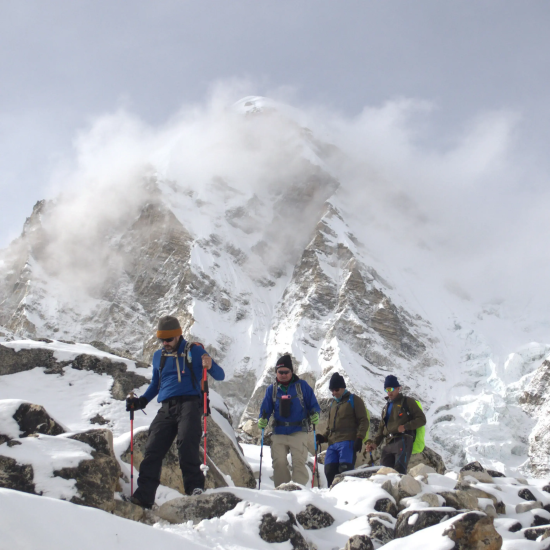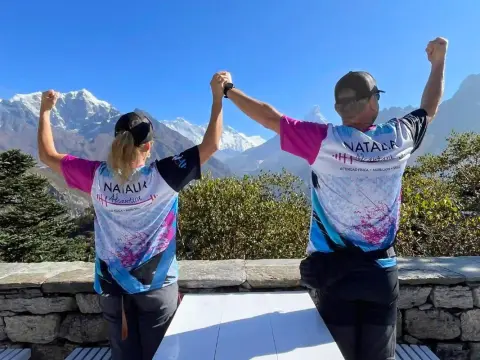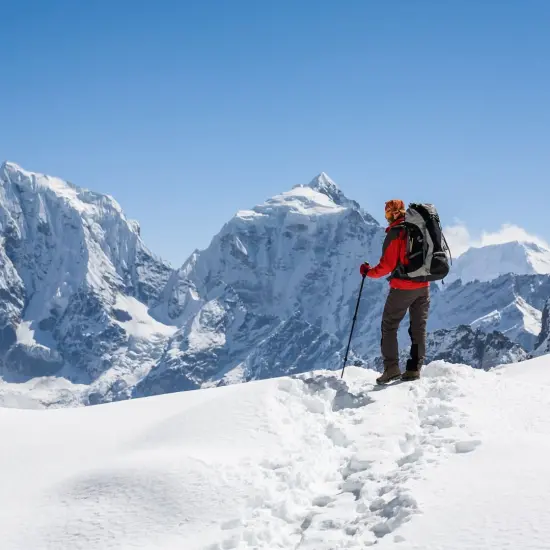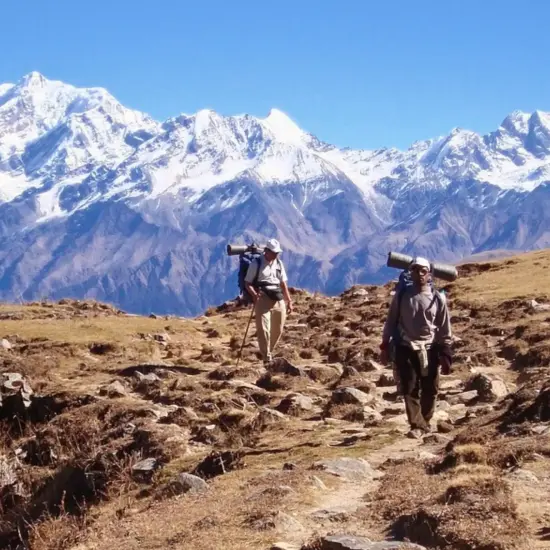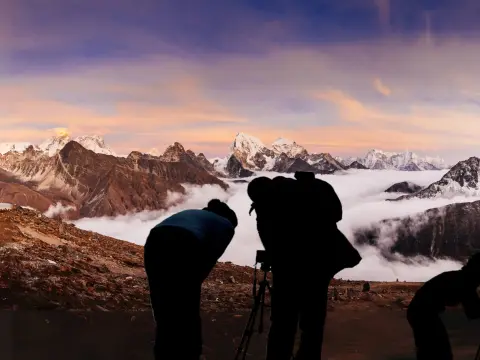More than a trek, the Everest Base Camp journey walks you through Sherpa villages, glacier valleys, and living history—where legends like Hillary and Tenzing once blazed the trail.
Since 1953, when Tenzing Norgay and Sir Edmund Hillary first summited Everest, this region has drawn explorers, dreamers, and trekkers from around the world. Today, the Everest Base Camp Trek from Lukla remains one of the world’s most iconic hiking adventures.
With decades of experience guiding trekkers through the Khumbu region, we’ve designed this guide to help you visualize each day on the trail. Whether you're comparing packages or preparing mentally for the adventure, our local knowledge ensures you're reading information you can trust.
Trek the Everest Base Camp Trek
This classic trek takes you through the heart of the Khumbu region, past vibrant Sherpa villages, ancient monasteries, and towering Himalayan peaks.
Day-by-Day Everest Base Camp Trek Itinerary
Day 1: Fly to Lukla (2,860m) & Trek to Phakding (2,610m)
Trek Duration: 3–4 hours
Max Altitude: 2,860m
Elevation Loss: -250m
What to Expect:
As your local guide, I’ll tell you — that 35-minute flight to Lukla is not just transport, it’s the first thrill. Lukla Airport sits on a steep ridge, surrounded by soaring peaks, making it one of the most challenging airports in the world. From here, we descend gently along the Dudh Koshi River, passing through dense pine forests and quaint Sherpa villages. You’ll notice Buddhist prayer wheels spinning in the breeze and mani walls carved with ancient mantras — these are signs of the deep spirituality of our people.
Tonight, we stay in a cozy teahouse in Phakding, where you’ll experience simple hospitality and traditional Sherpa warmth, perfect for your body to begin adjusting to the altitude.
Lukla Without Flight: If you prefer to skip the Lukla flight, the EBC trek is fully achievable by trekking in from lower-altitude starting points such as Jiri or Salleri. This route adds several days to your trek but rewards you with a richer, more authentic experience. Ultimately, this alternative trail merges seamlessly with the classic route, offering the best of both worlds.
Day 2: Phakding to Namche Bazaar (3,440m)
Trek Duration: 6–7 hours
Max Altitude: 3,440m
Elevation Gain: +830m
What to Expect:
Today’s trail is more challenging but filled with spectacular sights. We cross several suspension bridges, including the famous Hillary Suspension Bridge, named after Sir Edmund Hillary himself. The Dudh Koshi River roars beneath as we climb steadily through rhododendron and fir forests. As your guide, I’ll point out local flora and fauna — you might spot Himalayan birds or even a musk deer if you’re lucky.
Once we enter Sagarmatha National Park, a UNESCO World Heritage Site, the landscape becomes more rugged. Namche Bazaar, your destination, is the vibrant Sherpa hub—full of bustling markets, teahouses, and stunning views. Our accommodation here is in comfortable lodges that offer warm meals and cozy rooms, a welcome respite after the climb.
Day 3: Acclimatization Day in Namche (Hike to Everest View Hotel – 3,880m)
What to Expect:
Acclimatization is vital at this altitude. We’ll take a day hike to the Everest View Hotel, perched high above Namche. From here, you get some of the best panoramic views of Everest, Lhotse, Nuptse, and Ama Dablam — truly breathtaking. Along the way, we’ll visit the Sherpa Culture Museum, where you can learn about the history and traditions of my people.
The trail is moderate, and the fresh mountain air energizes you. In Namche, you’ll find cozy cafés with freshly baked bread and even internet access — a rare luxury here.
Day 4: Namche Bazaar to Tengboche (3,867m)
Trek Duration: 5–6 hours
Max Altitude: 3,867m
Elevation Gain: +427m
What to Expect:
The trek today is one of my favorites. We follow the hillsides with Everest and Ama Dablam always in view. After lunch at Phunki Tenga by the river, we ascend through fragrant rhododendron forests to Tengboche, home to the famous monastery.
The monastery is the spiritual heart of the Khumbu region and holds daily prayer ceremonies that offer a glimpse into Sherpa Buddhist life. Staying overnight here means you can attend the evening prayer service — the chants echoing against the backdrop of towering peaks create a peaceful, almost magical atmosphere. The teahouses here are simple but warm, with great hospitality.
Day 5: Tengboche to Dingboche (4,410m)
Trek Duration: 5–6 hours
Max Altitude: 4,410m
Elevation Gain: +543m
What to Expect:
Today we descend briefly into a valley before climbing again toward Dingboche. The air thins noticeably here, and the landscape opens into high alpine fields dotted with yak pastures and stone walls protecting potato crops. Pangboche village is an interesting stop — it’s home to the oldest monastery in the region and has some ancient Buddhist artifacts.
The teahouses in Dingboche are basic but cozy, designed to shelter you from cold mountain winds, and the night sky here is perfect for stargazing.
Day 6: Acclimatization Day in Dingboche (Hike to Nangkartshang Peak – 5,083m)
What to Expect:
This acclimatization day is essential for a safe ascent. We’ll hike up to Nangkartshang Peak, a steep but rewarding climb. From the top, you’ll see Makalu, Lhotse, Island Peak, and Ama Dablam all stretching across the horizon.
The views are spectacular and well worth the effort. Returning to Dingboche, take time to learn about the local farming lifestyle — stone terraces and yak herding are part of daily life here, showcasing the Sherpas’ resilience in this harsh environment.
Day 7: Dingboche to Lobuche (4,910m)
Trek Duration: 5–6 hours
Max Altitude: 4,910m
Elevation Gain: +500m
What to Expect:
We leave the green fields behind and enter a more barren, rocky landscape. The climb to Thukla Pass is physically demanding but sobering. At the pass, memorials honor climbers who have perished on Everest — a poignant reminder of the mountain’s power.
The village of Lobuche lies just beyond, small and windswept, with teahouses that provide simple meals and shelter. It’s quieter here, and the surrounding peaks feel close enough to touch.
Day 8: Lobuche to Gorak Shep (5,164m), Hike to Everest Base Camp (5,364m)
What to Expect:
The big day! From Lobuche, we trek across moraine and glacial debris to Gorak Shep, the last village before Base Camp. After a quick rest, we push to Everest Base Camp itself. The terrain is rocky and glacial — challenging but exhilarating. You’ll see the Khumbu Icefall up close and feel the mountain’s raw energy.
The Base Camp is not Everest’s summit, but standing here surrounded by prayer flags and the imposing peaks is unforgettable. Return to Gorak Shep for a night in a rustic teahouse, where hot soup is especially comforting.
Day 9: Hike to Kala Patthar (5,545m), Trek to Pheriche (4,240m)
What to Expect:
Before dawn, we climb Kala Patthar — the highest point of the trek. This climb is tough but rewards you with the most stunning, unobstructed view of Everest’s summit, lit golden by the sunrise. After capturing this breathtaking panorama, we descend to Pheriche, a quiet village known for its Himalayan Rescue Association clinic. The teahouses here are simple but welcoming, a good place to rest and reflect.
Day 10: Pheriche to Namche Bazaar (3,440m)
What to Expect:
Retracing our steps through Pangboche and Tengboche, you’ll enjoy the sights once more but with lighter legs. The rhododendron forests and prayer flags guide us back to Namche, where the warmth of Sherpa hospitality awaits. Take a hot shower, enjoy some freshly baked treats, and soak in the bustling market atmosphere.
Day 11: Namche Bazaar to Lukla (2,860m)
What to Expect:
Our final trekking day winds gently downhill through familiar villages and forests. This day feels both easy and emotional — a time to appreciate how far you’ve come. Back in Lukla, celebrate with your guide and porters over a hearty meal. This town’s energetic vibe reminds you that while the trek ends here, the memories will last forever.
Day 12: Fly to Kathmandu
What to Expect:
Weather permitting, you’ll fly back to Kathmandu early morning, with stunning aerial views of the Himalayan giants you’ve just conquered. Back in the city, rest or explore, knowing you’ve walked a legendary path few ever do.
Explore More: Other Everest Region Trekking
Trek the Everest View Panorama Trek
An easy yet rewarding journey to Nepal’s most spectacular mountain vistas. Ideal for first-time trekkers, senior citizens, children and family.
At Places Nepal Treks and Expedition, we know that trekking to Everest Base Camp is just one way to experience the magic of the Khumbu. Whether you're returning for a second journey, short on time, or looking for a greater challenge, the Everest region offers more than one path to the Himalayas’ heart.
Here are our most recommended Everest region adventures for this year:
Trek the Everest Three Passes Trek
Conquer the Three Passes, Experience Everest’s Ultimate Trekking Adventure.
Duration: 17 Days | Max Altitude: 5,535m (Kongma La)
Conquer Renjo La (5,360m), Cho La (5,420m), and Kongma La (5,535m) in a single circuit that also includes Everest Base Camp and Gokyo Lakes. This trek is for experienced trekkers seeking solitude, sweeping glaciers, and 360° summit views.
✅ Ideal for seasoned hikers seeking adventure beyond the standard trail.
✅ Fewer crowds, deeper immersion.
Gokyo Lakes & Cho La Pass Trek – The Scenic EBC Alternative
Duration: 16 Days | Max Altitude: 5,420m (Cho La Pass)
This spectacular route combines the pristine turquoise lakes of Gokyo with a dramatic crossing of Cho La Pass—leading you to Everest Base Camp through a quieter, more photogenic trail.
✅ Best for photographers and off-the-beaten-path trekkers.
✅ Includes panoramic views of Everest from Gokyo Ri (5,360m).
EBC Trek with Helicopter Return – Luxury Meets Adventure
Duration: 9 Days | Max Altitude: 5,545m (Kala Patthar)
Trek to Everest Base Camp and then fly back by helicopter, soaring over glaciers and peaks in just 20 minutes. Save time, avoid the descent, and reward yourself with a dramatic aerial finale.
✅ Perfect for those with limited time.
✅ Includes EBC, Kala Patthar, and 5-star mountain lodges (optional).
Trek the Everest View Panorama Trek
An easy yet rewarding journey to Nepal’s most spectacular mountain vistas. Ideal for first-time trekkers, senior citizens, children and family.
Duration: 9 Days | Max Altitude: 3,880m (Everest View Hotel)
A shorter trek designed for beginners or families, this route visits Namche Bazaar, Tengboche Monastery, and offers stunning views of Everest without the high-altitude stress.
✅ Great for first-timers and those wanting culture + views.
✅ Easier acclimatization and flexible schedules.
Pikey Peak Trek – Sir Hillary’s Favorite View of Everest
Trek the Pikey Peak Trek
Trek the Pikey Peak: Authentic Sherpa Warmth & Panoramic Everest Vistas
Duration: 9 Days | Max Altitude: 4,065m (Pikey Peak)
Less commercial, more local—this lower Solukhumbu route offers extraordinary sunrise views of Everest without the crowds. Trek through peaceful villages, Buddhist shrines, and ridgeline trails.
✅ Ideal for those seeking solitude and authenticity.
✅ No flights to Lukla required.
Trek the Island Peak Climbing
Climb Island Peak (6,189m) on a 16-day expedition through the Everest region, complete with acclimatization, technical training, and jaw-dropping Himalayan views.
Duration: 16 Days | Max Altitude: 6,189m
Start with the EBC trek, then summit Island Peak, a non-technical 6,000-meter climbing objective perfect for fit trekkers. This is your bridge between trekking and true mountaineering.
✅ Includes full climbing gear and Sherpa guidance.
✅ Best for adventurers looking to go higher.
Trek the Everest Base Camp and Gokyo Lakes Photography Expedition
Embark on an 18-day photography adventure to the legendary Everest Base Camp and the pristine Gokyo Lakes
Duration: Custom | Max Altitude: Based on itinerary
Join our guided media-focused expeditions where sunrise shoots, drone perspectives, and cultural portraits are part of the journey. Includes custom pacing, location scouting, and local immersion.
✅ Tailored for content creators, journalists, or film crews.
✅ Available with porters, guides, and logistics support.


